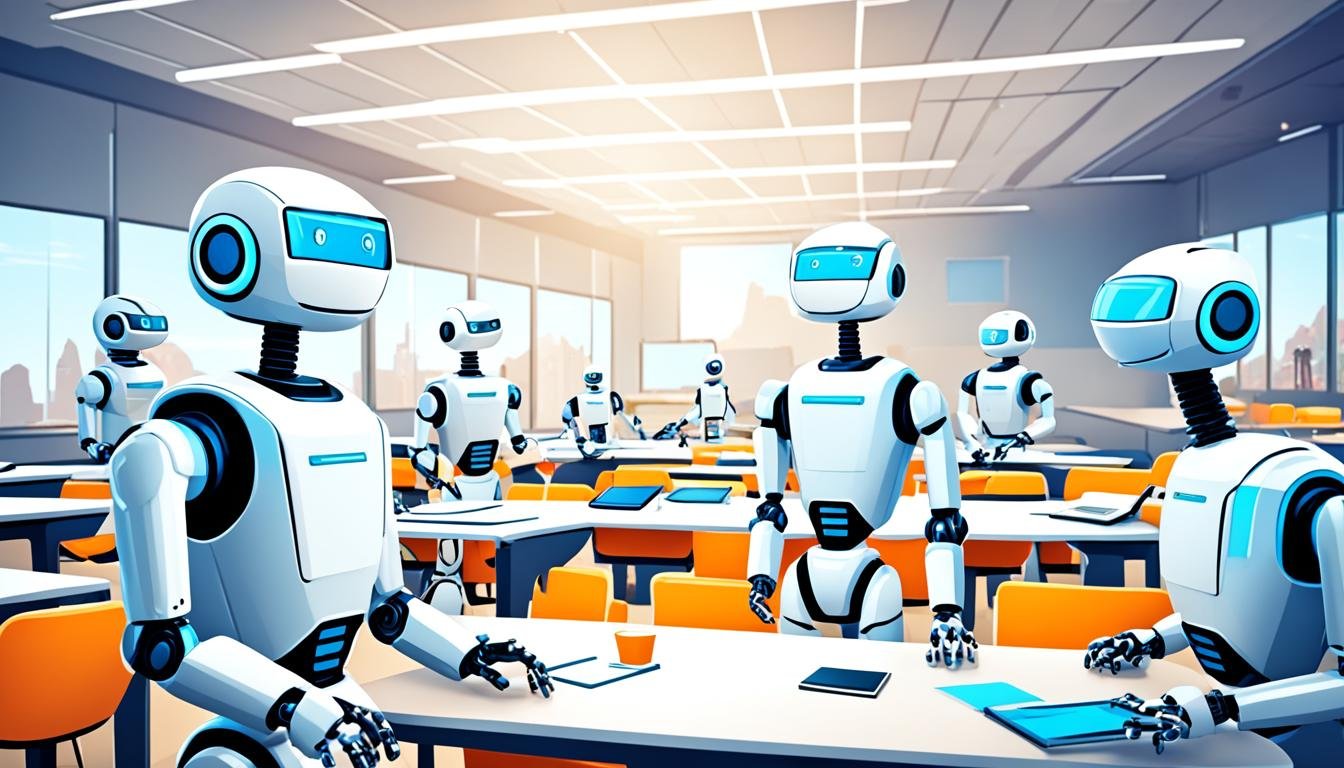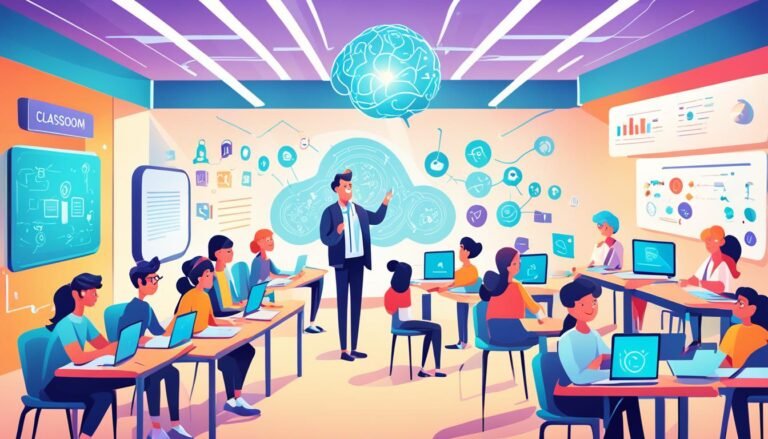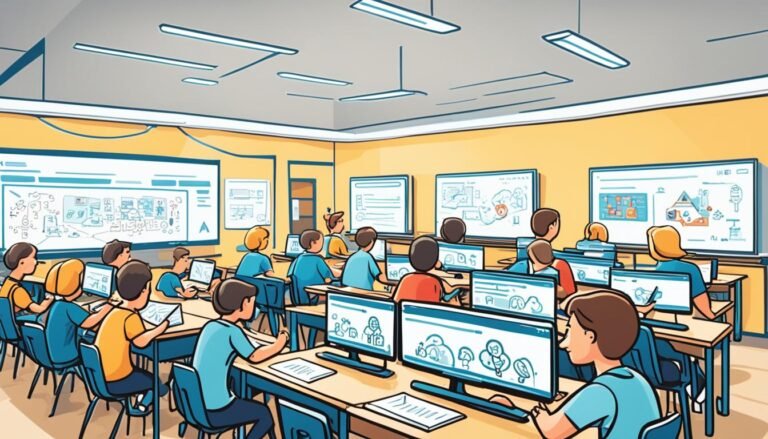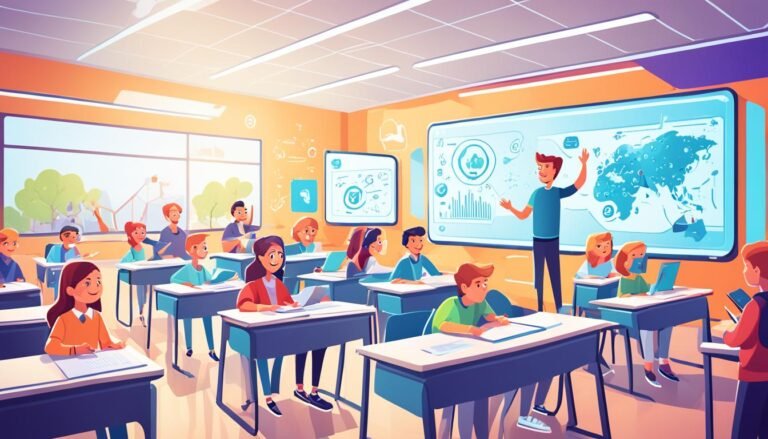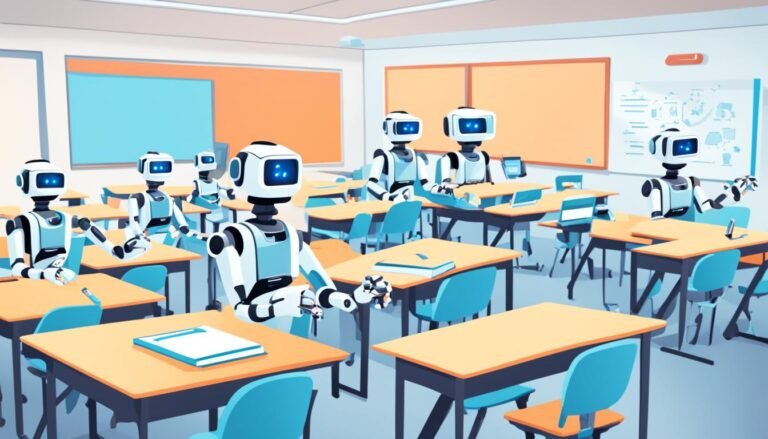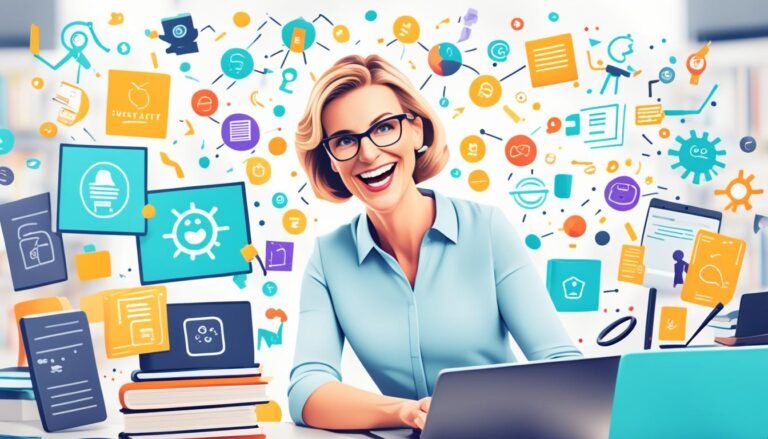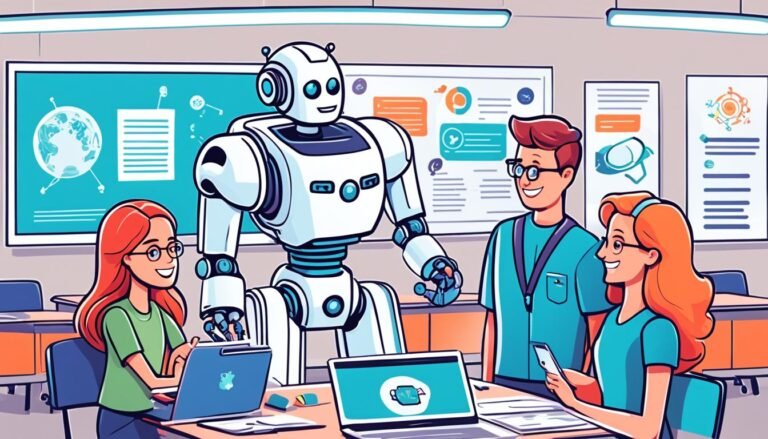AI in Educational Content Creation: Revolutionizing Learning
Picture a classroom where each student gets lessons made just for them. This idea used to be hard because it needed teachers to do a lot more work. But now, AI is making it real. With AI, lessons are personalized. This gives teachers more time to help students right in the classroom.
An elementary school teacher spent many hours after class searching the web for good lesson materials. Now, thanks to AI, this job is much easier. She can use this extra time to be more creative in teaching. She can also give more one-on-one time to students. This makes learning better for everyone, meeting each student’s special needs.
Key Takeaways
- AI in educational content creation is changing how teachers get and make lesson materials.
- AI tools create special lessons just for each student.
- By looking at how students do, AI can make teaching better.
- AI helps by making learning easier for everyone.
- There are problems like wrong data and being fair that we need to fix for AI to work best.
The Impact of AI on Education
Artificial Intelligence (AI) is changing how we learn, making it better for everyone. It’s making education more personal and fair. Teachers are using AI tools to create a unique experience for each student.
Enhancing Teaching Roles
AI is giving teachers a lot of help through new tools. These tools do things like grade work and plan lessons. With AI doing these tasks, teachers have more time for working directly with students. This makes learning more personal and fun for everyone.
AI also helps students with disabilities. For example, it reads aloud for those who can’t see well and transcribes speech for the deaf. This makes sure all students can do well in school.
Automating Administrative Tasks
AI is also improving how schools run. It does things like handle data and make schedules. This takes a lot of work off the teachers and others, letting them focus on teaching. Schools work better as a team this way.
This setup not just makes things run smoother. It also helps teachers teach in cooler ways. As AI gets better, it will make learning even more interesting for students.
Still, we need to make sure AI is used the right way. It should give every student, no matter their background, a chance to learn better. AI should help and treat everyone fairly.
Personalized Learning Experiences with AI
Artificial Intelligence (AI) is changing how we learn. It personalizes education for each student, meeting their unique needs. Such tech makes learning more efficient and effective.
Adaptive Learning Technologies
AI-powered systems look at a student’s performance and needs. They then recommend the best learning tools. These tools can use different methods like audio, video, and interactive elements. This helps all students learn in a way that’s best for them.
These systems can also include smart chatbots and virtual teachers. They talk to students, give tips, and help them learn better. This makes learning more fun and effective for everyone.
Customized Learning Paths
AI creates special learning paths for each student. For example, it lets students pick their reading material. This keeps them more interested and helps them do better in school. Studies show that personalized learning like this makes students more engaged and improves their grades.
AI can even predict if a student is going to have trouble. Then it helps the student with extra tips and support. By giving this extra help, students feel more confident and do better in their studies.
| AI in Education | Impact |
|---|---|
| AI in Learning Management Systems | Over 47% projected adoption within three years |
| Global AI in Education Market Growth | 36.0% CAGR from 2022 to 2023 |
| Adaptive Learning Program Results | 62% increase in test scores |
| Personalized Guidance Accuracy | 91% accuracy with AI chatbots |
In the end, AI in education is changing the game. It helps teachers give each student a special learning experience. This way, every student can learn better and enjoy school more.
AI-Powered Assessment and Analytics
AI is changing how we look at education. It’s making tests and grading easier. Automated systems can test and give feedback fast. This helps teachers see what students need quickly.
Automated Grading Systems
AI has brought us automated grading systems. They grade tests the same way every time. This makes sure test scores are fair for everyone.
These systems use NLP to understand what students write. They help teachers focus on fun ways to teach. They also point out where students might be confused. This helps teachers to adjust their lessons to help students better.
Real-Time Feedback and Insights
AI can give feedback right away, changing how teachers help students. It looks at lots of data on what students are doing. Then, it helps teachers adjust lessons to fit students better.
Students learn in ways that fit them best. This makes learning more interesting and helps students do better in school.
Here are some numbers that show AI’s big effect on education:
| Projections and Statistics | Details |
|---|---|
| Online Education Market Revenue | Expected to hit approximately $166.60 billion by 2023 (Statista) |
| AI in Education Market Value | Valued at USD 1.82 billion in 2021, projected to grow at a CAGR of 36.0% from 2022 to 2030 (Grand View Research) |
| AI Technologies in Educational Content Creation | Providing tools for speech recognition, image-description generation, plagiarism detection, assessment, grading, and more |
These numbers show AI is making big changes in education. There will be even more ways AI helps teachers and students in the future.
Intelligent Tutoring Systems
AI’s intelligent tutoring systems (ITS) are changing education by being like personal tutors. They give custom lessons and feedback. This helps students learn tough things and boosts their confidence.
One cool thing about ITS is they give feedback right away. This means mistakes can be fixed fast. As students use them, ITS learn more about what the student knows. It then adjusts the lessons to fit their needs.
ITS often use natural language processing (NLP). This makes learning fun and interactive. In subjects like math and science, they might show images or let students do experiments. This makes learning and remembering things easier.
ITS use special computer programs to figure out what each student needs to learn. This way, they help students more than the old ways did. Learning becomes fun because it feels like a game.
ITS also collect data to get better and help teachers too. They can teach many students all at once. This saves schools money and helps more students at the same time.
But, there are some challenges too. We need to protect student’s data and make sure everyone can use ITS, like students with disabilities. Keeping the lessons up to date is important. And teachers need help to see how good ITS are for learning.
ITS and other AI in education are making a big difference. They make learning better for students everywhere. Teachers like them too because they make teaching easier, leading to better results for everyone.
| Feature | Benefit |
|---|---|
| Immediate Feedback | Helps quickly correct misconceptions |
| Adaptive Content | Keeps students engaged and motivated |
| NLP Integration | Makes learning interactive and engaging |
| Simulated Environments | Enhances hands-on learning and retention |
| Data Analytics | Informs system refinement and instructional design |
To sum up, ITS and AI are making education better for all. They make learning personal, easy, and helpful. Thanks to these new tech, students are doing better in school around the world.
Content Automation and Curation
AI is changing how we find and create educational content. It uses machine learning to pick out the best resources for learning. This tech can look through a lot of data quickly. Then, it makes easy-to-read summaries and fun learning materials like games and simulations.
Machine Learning in Content Creation
Machine learning is great at finding what content is popular and new. It can search the internet all the time for what you need. Tools such as Buzzsumo and Curata help by giving useful information. This way, people save time and their work gets smarter. Marketers love using AI because it makes their job 40% more efficient. About 33% use AI to come up with content ideas.
Curating Relevant Educational Materials
AI makes it easy for teachers to mix different learning materials. This creates cool learning experiences for kids. With AI searching for materials, teachers get extra time. They can now focus on making the material fun and engaging. Companies like Outbrain and Taboola show how AI helps by suggesting personalized content.
It’s important to watch over these AI systems. This makes sure everything is fair and keeps people’s private info safe. With AI, students and teachers get to enjoy learning in new ways. We’re seeing more trends like using natural language and AR. These trends are styling the future of learning with the help of AI.
| Benefit | AI-Powered Tool | Outcome |
|---|---|---|
| Streamlining Workflows | Buzzsumo, Curata | Enhanced decision-making |
| Increasing Productivity | Outbrain, Taboola | 40% increase in productivity |
| Content Ideation | Various AI tools | 33% of marketers benefit |
| Engaging Audiences | AI Algorithms | 20% increase in engagement |
Supporting AI and Digital Literacy
Digital literacy is a key skill as we move through the Fourth Industrial Revolution. The World Economic Forum says we need big changes in education to keep up. They focus on using AI to help students learn better.
AI is great at helping students think critically and solve problems. It does this by creating personalized lessons with AI tools. These lessons meet each student’s unique needs. They help everyone learn better, making education fairer and easier to get.
But, there aren’t enough teachers worldwide, and we need more. The work teachers do is very important. Also, they’re going to use more AI in their teaching.
Bridging the Digital Skills Gap
Because AI is getting more important, teachers need to focus on digital skills for students. A study from DEF Educational Consulting found 82% of students think it’s key for future jobs. AI tools not only teach digital skills but also give instant feedback. This helps teachers know how to help students better.
| AI Tool | Function | Benefits |
|---|---|---|
| Adaptive Learning Technologies | Customized educational experiences | Improves learning outcomes, caters to diverse needs |
| AI-Enabled Assessments | Automated feedback and evaluations | Identifies trends, saves time, supports teachers |
| Personalized Tutoring Systems | Individualized student support | Outperforms traditional teaching methods |
Teaching AI Development and Ethical Use
Lessons on AI and how to use it ethically in school are really important. These lessons get students ready to work with AI and understand its ethics. A study by ABC Educational Solutions found 68% of teachers need AI training. They want to use AI lessons better.
Teaching about AI and its ethics helps students learn to use AI tools well. This is good for our world and economy. We need to invest in education so that AI can help everyone.
AI in Educational Content Creation
The use of AI in educational content creation is growing fast. AI tools are making it easier to create custom learning materials. A recent report shows that over half of Education Services teams haven’t started using AI for making content. This shows a big opportunity to improve content creation with AI.
Teams in education are finding AI tools very useful. Video creation is especially getting faster with tools like Videate and Synthesia. They can speed up the process up to 10 times. For voice content, tools such as HeyGen AI and Camb.ai offer fast, natural-sounding voices in many languages.
Tools like Clueso and Scribe are changing how we make help articles. They can turn videos into easy-to-follow steps with pictures. When it comes to creating lessons and tests, tools like Writer and LEAi can save up to 98% of the time. This highlights how important AI is becoming in content creation.
An 80/20 strategy is often recommended. Let AI do most of the work, but have people check the final product. This helps keep the content right for learners. Always making sure these tools work well is key, with tools like ChatGPT helping make text more human-like.
But, we must also watch out for problems like doing too much with AI and keeping it fair. Checking AI’s work against human knowledge is a must. By using AI wisely, educators can combine its power with human skill. This can improve how people learn in big ways.
| Tool Category | Examples | Efficiency Gains |
|---|---|---|
| Video Creation | Videate, Synthesia, Descript, Capsule | Up to 10x faster |
| Voiceover Tools | Eleven Labs, HeyGen AI, Murf.ai, Camb.ai, WellSaid Labs | Rapid voice content creation |
| Help Article Creation | Clueso, Scribe, Tango | Streamlined tutorials |
| Course Content Creation | Writer, LearnExperts AI, Learnt.AI, SummarAIze | Up to 98% time savings |
Improving Accessibility and Inclusivity
Adding AI to education makes it easier for all students to learn and take part. It gives students different tools to help them learn better. This way, everyone can join in learning, no matter their needs.
AI Tools for Diverse Learning Needs
AI helps with different learning needs by offering tools like speech-to-text and text-to-speech. It also includes image recognition. These tools make learning better for people who need them. They can even change assignments to formats they prefer.
This makes learning more open for all students. It fits many needs and styles, helping everyone learn in the best way for them. This approach falls under the Universal Design for Learning. It especially helps students who need more time or fewer distractions to get their work done well.
In recent years, more students with disabilities have been welcomed into schools. For example, charter schools saw 86.60% of students with disabilities being included in the 2017–2018 year. This showed an annual growth of 1.67%. Florida also saw better inclusion from 2010 to 2020, no matter the disability rates there. This spread of inclusivity is a big step forward for education.
| School Type | Inclusion Rate (%) | Difference from Charter Schools (%) |
|---|---|---|
| Charter Schools | 86.60 | 0 |
| High Schools | 70.15 | -16.45 |
| PK–8 Schools | 58.42 | -28.18 |
| Middle Schools | 56.22 | -30.38 |
| Alternative Schools | 54.44 | -32.16 |
| Elementary Schools | 46.81 | -39.79 |
Breaking Down Language Barriers
AI is also great at smashing language barriers in schools. It translates lessons for all students, no matter what language they speak. For example, Google’s Live Transcribe makes spoken words into text in real time. And closed captions on Netflix help everyone enjoy shows and movies better.
In 2023, GIPHY and an accessibility provider plan to add alt text to 10,000 commonly shared GIFs. This will make these GIFs more usable for all, promoting digital inclusion.
But we need to make sure that AI doesn’t show any bias. It’s important that it represents everyone well, including those with disabilities. Reviews on AI tools help check if they work well with special technologies, like screen readers. This kind of checking ensures that the learning environment is good for all students.
AI-Enhanced Virtual and Augmented Reality
Advanced AI mixed with virtual and augmented reality changes education. It creates exciting new ways to learn. Students get to do hands-on exercises and understand complex ideas better.
Immersive Learning Environments
AI makes learning in VR custom-fit to how each student learns best. It looks at how students learn and what they like. Then, it makes sure the lessons match each student perfectly.
In virtual reality, students get to learn by doing things that are hard, dangerous, or just not possible in real life. They can do science experiments in a lab, fly through the solar system, and see history up close. This makes learning more exciting and helps students remember better.
Interactive Simulations
When AI and augmented reality work together, learning becomes more dynamic and fun. They make learning like playing a game. For example, in medical school, students can practice surgeries without any risk. This is all thanks to AR.
AI, AR, and VR give teachers new tools to make learning more interesting and personal. Google Expeditions lets students go on more than 100 AR trips. They can explore historical places or go into space. This makes learning an adventure everyone can enjoy.
| Feature | Benefit | Application |
|---|---|---|
| Personalized Learning | Tailors educational content to individual needs | VR and AR environments |
| Immersive Experiences | Engages learners in practical, hands-on activities | Virtual labs, historical explorations, space travel |
| Interactive Simulations | Enhances engagement and provides tailored feedback | Medical education, scientific experiments |
| Global Accessibility | Breaks down geographical barriers | Remote learning, AR expeditions |
The Future of AI in Education
AI is becoming key in the world of education. It greatly enhances teaching and learning. The future of AI in education looks bright. It will change how we learn for the better. Educators can now give more personalized help and create pathways for every student. This is all thanks to AI.
Ongoing Advancements
More than 60% of teachers worldwide use AI to help teach better. This technology targets personal learning and smart tutoring. The rise of AI tools like ChatGPT shows that people are liking AI in education. These trends highlight AI’s positive role in the classroom.
Challenges and Ethical Considerations
But, AI in education faces big ethical challenges. We must worry about things like who owns our data and if the AI is fair. Right now, many schools don’t have clear rules on how to use AI. Setting up these rules is crucial to keep AI helpful and safe for students and teachers.
AI can make teaching and learning better by doing some tasks for us, giving detailed feedback, and making communication easier. But, we must use AI in a smart and safe way. This will help build a future where technology and learning go hand in hand. And, where everyone gets a fair chance.
| Key Statistic | Data |
|---|---|
| AI-Driven Classrooms Impact | 60% of educators report streamlined teaching |
| ChatGPT Users | 100 million monthly active users in January 2023 |
| Funding for AI Content Creation Platforms | Gurushala received $2 million |
Conclusion
AI in education works to copy human thinking, spotting patterns, solving issues, and learning from stories. It dreams of becoming as skilled as the human intelligence, so it can do a lot more on its own. This makes a big change, turning how we teach and learn upside down.
In the future, AI will change learning to be tailored, quick, and easy to get. It makes grading faster, letting teachers spend more time with students. Also, it gives teaching new life, guiding teachers on what works best. But, there are worries about less human touch, keeping data safe, unfair computer choices, and high costs.
AI shines in making school more fun and helpful for grades K-12. It boosts lessons with cool stuff and tests that adjust to each student. Fun learning games and virtual worlds also help kids learn by doing. The future looks bright, with AI bringing new ways for everyone to learn and teachers to teach. Reports say almost half of teaching tech will use AI by 2024. As we welcome these changes, finding a good mix of tech and human care is key to keeping education strong for all.
Source Links
- AI in Education: Revolutionizing Content Creation & Curation
- The AI Revolution In eLearning: A Comprehensive Overview
- AI for Educational Content Creation
- Inclusive Intelligence: The Impact of AI on Education for All Learners – CIDDL
- The Impact of AI in Education on Teaching and Student Success
- The Impact of AI on Educational Content Creation: Shaping the Future of Learning Materials
- How AI Is Personalizing Education For Every Student
- AI and the Future of Personalized Education
- The Role of AI in Personalized Learning
- AI in education: Use cases, solution and implementation
- 10 Ways Artificial Intelligence Is Transforming Instructional Design
- 6 AI Use Cases in Educational Content Creation
- Use Case 2:10 Revolutionizing Education with AI Intelligent Tutoring Systems (ITS)
- AI in Education: Pros & Cons of Intelligent Tutoring Systems
- Artificial intelligence in intelligent tutoring systems toward sustainable education: a systematic review – Smart Learning Environments
- Automating Content Curation: How AI Tools Can Help Content Creators
- The role of AI in streamlining content creation | Kontent.ai
- AI in Content Creation: Top 25 AI Tools
- The future of learning: AI is revolutionizing education 4.0
- Research Guides: Artificial Intelligence (AI): AI in Teaching
- Generative AI in Educational Content Creation
- 16 AI Tools for Education Content Creation
- AI Writing and Content Creation Tools – MIT Sloan Teaching & Learning Technologies
- Exploring AI in eLearning Content Creation
- AI & Accessibility | Center for Teaching Innovation
- Enhancing Accessibility and Inclusivity in Education with ChatGPT – iZen.ai
- How Artificial Intelligence (AI) Helps Improve Accessibility
- The Intersection of AI, VR, and AR in Content Creation
- The Intersection of AI, AR, and VR in Education: Crafting Immersive Learning Experiences
- Augmented Reality and AI in Education
- AI in Education: Transforming Teaching and Learning
- AI in Education: Benefits, Use Cases, Challenges, Cost & More
- The past, present and future of AI in education
- What is the Conclusion of Artificial Intelligence in Education?
- The Transformative Role of AI in Education and Learning | Cloudely
- How School Marketers Can Use AI For Content Creation | SchneiderB Media

